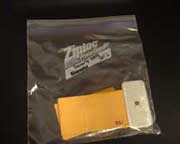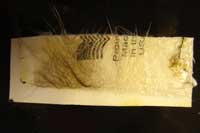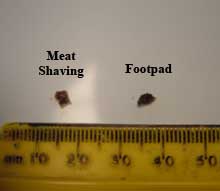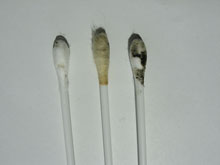|

In general, we accept only samples that have been completely dried and are stored in breathable containers such as unwaxed paper coin envelopes. For details on how to prepare specific sample types, please see "Types of Samples" below. If your samples have been collected or stored in any other way, please contact us for information regarding the feasibility of processing your samples.
If you work in a humid environment, or are concerned about exposure to moisture during shipping, it is acceptable to place the paper sample envelopes in non-breathable containers (e.g. ziplock bags), but only if breathable containers of desiccant are included with the sample envelopes. Desiccant is available at low cost online. |

An example of sample storage with desiccant |
Types of Samples |
Hair Sample Collection
 Hair samples plucked from live animals have simple storage requirements and can routinely produce excellent data. For these reasons the majority of the samples that we handle are plucked hair. If you are pulling hair samples out of an animal, look for coarse hairs that are clean and hard to remove. For example, the white, tail hairs from white-tailed deer are a very reliable sample type. A person with good eyesight will be able to hold the hairs up to the light and clearly see root bulbs. Hair samples plucked from live animals have simple storage requirements and can routinely produce excellent data. For these reasons the majority of the samples that we handle are plucked hair. If you are pulling hair samples out of an animal, look for coarse hairs that are clean and hard to remove. For example, the white, tail hairs from white-tailed deer are a very reliable sample type. A person with good eyesight will be able to hold the hairs up to the light and clearly see root bulbs.
Note that hair samples remove relatively little DNA when plucked from dead animals, even within hours of death. Good alternatives for dead animals are a piece of footpad or ear tip (any tissue sample should be smaller than a corn kernel).
Shed hair, or hair that has passed through a digestive tract, is an inferior source of DNA. Such hair may only provide species data based on mtDNA analysis. For this reason, trap devices that pluck hair (sticky pads or barbed wire) produce better results than devices that comb out hair that is already loose. |
Tips for Sticky Traps
- Use the appropriate size of trap (not too large)
- Cover the trap with write in the rain paper
- It is convenient to have follicles hanging off the edge, but we can remove folicles from the adhesive without loss of sample quality
|

Sticky Trap |
Hair Sample Storage
 Hair samples should be stored dry in unwaxed paper envelopes. Hair samples should be stored dry in unwaxed paper envelopes.
Please avoid the use of plastic bags for sample storage, as they can retain moisture in your sample and therefore can degrade sample quality (see general comments on sample storage). |
 Dry tissue samples are an excellent source of DNA, and convenient for us to process. The amount of material should be no greater than a corn kernel, and it should be stored at room temperature in a coin envelope. If the tissue doesn't dry quickly after coming into contact with the paper envelope, you are collecting thicker pieces than necessary. If you are concerned about the tissue falling out of the envelope and getting lost, use scotch tape to fix it to the inside wall of the envelope. Dry tissue samples are an excellent source of DNA, and convenient for us to process. The amount of material should be no greater than a corn kernel, and it should be stored at room temperature in a coin envelope. If the tissue doesn't dry quickly after coming into contact with the paper envelope, you are collecting thicker pieces than necessary. If you are concerned about the tissue falling out of the envelope and getting lost, use scotch tape to fix it to the inside wall of the envelope.
Some of our favourite examples of tissue samples are as follows: Footpads, which have dried without decaying before an animal dies, are one of the least likely parts of the animal to decay after death. A small chunk of footpad is often the ideal sample from a dead animal. The tip of a small mammal's ear, which is thin enough to dry without rotting. Snip a piece several mm square. Muscle tissue that doesn't smell rotten, including tissue removed from biopsy darts, which will dry safely in a paper envelope as long as the tissue isn't too thick. Shave muscle tissue thin enough to be translucent. |
 We no longer accept liquid blood samples. We no longer accept liquid blood samples.
Blood can be stored dry at room temperature for many years. To prepare blood samples, lightly dip a Q-tip in the blood and allow it to dry, then store it in an unwaxed paper coin envelope. If you don't have Q-tips, just spot the blood onto a piece of printer paper and allow it to dry. Buccal swabs provide a relatively non-invasive way to sample an animal that is in hand. Simply rub something absorbent on the inside of a cheek and then store it in a paper envelope. Saliva samples can also be obtained in the field, for example by using a Q-tip to swab around bite wounds on a prey animal. |
Bone and Antler Sample Collection
 Bone and antler samples can be a good source of DNA assuming that they have not decayed while they dried out. Collect samples by drilling into the core of the bone or antler to the full depth of a 3mm (1/8") drill bit. Don't burn the sample! Bone and antler samples can be a good source of DNA assuming that they have not decayed while they dried out. Collect samples by drilling into the core of the bone or antler to the full depth of a 3mm (1/8") drill bit. Don't burn the sample!
Bone and antler shavings should be stored dry in unwaxed paper envelopes. Tape the envelope closed if you are worried about shavings leaking out. |
Scat Sample Collection and Storage
Please note that we no longer accept actual fecal material.
Instead, we encourage the use of surface rubs with an absorbent device like a Q-tip brand swab. In addition to improving success rates, this approach obviates the need for sample drying, simplifies storage and shipping, and reduces the risk posed to workers by parasites in the feces. |
Scat should be sampled by taking three surface rubs of each scat, ideally sampling from the pinched end (ie. the end that exits the animal last). Use enough intensity that the swab is stained without being completely covered in fecal material (see picture).
Depending on such variables as the study species, diet, field conditions and sample age upon collection, fecal samples can be an outstanding source of DNA (e.g. Poole et al. 2010) or a tremendous waste of time. For these reasons, it is important to talk to us before submitting fecal samples, and preferably prior to sample collection. |

The scat swab in the middle has been sampled with the correct intensity, whereas the swab on the left will fail because it does not have enough sample to produce a good result, and the swab on the right will fail because it has too much fecal material.
|
The lab process, and thus pricing, depends on the quality of fecal collections. Under ideal conditions, fecal samples can be processed with the same highly efficient protocols that we use for hair. At other times it will be necessary to replicate the analysis several times and quantify data reproducibility for each sample. A pilot study may be required to identify the optimal lab strategy. |
 Avian blood and feathers are some of the most reliable sources of DNA that we have handled. Avian blood can be collected and stored in the same way as other blood samples (see above).Feathers should be stored dry in unwaxed paper envelopes. Avian blood and feathers are some of the most reliable sources of DNA that we have handled. Avian blood can be collected and stored in the same way as other blood samples (see above).Feathers should be stored dry in unwaxed paper envelopes. Eggshell membranes are also a good source of DNA. A small (~1cm x 1cm) piece of eggshell can be attached with cellophane tape to a breathable paper envelope. Tape the eggshell from the outer edge to avoid the risk of trapping moisture in the membrane. Unhatched eggs should be cracked and dried as soon as possible.
Import restrictions on avian samples from outside Canada are evolving with the ongoing spread of highly pathogenic avian influenza. Check the CFIA recommendations for your location before preparing a shipment. |
|
Contamination with Human DNA
Unless your study species is a primate, the microsatellite markers that we use will not work on human DNA. Markers that work across a broad range of species, such as gender markers, have been tested by us to ensure that human banding patterns cannot be confused with banding patterns from study species. For these reasons, we do not feel that it is necessary to wear gloves or a face mask to prevent contamination of samples with human DNA. We will leave it to you to determine if gloves and masks are necessary to protect the health of field workers (e.g. when handling feces). |
|
| |
l |
|

